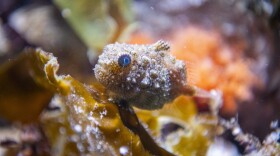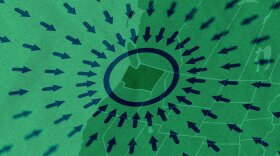How do you make something called a “slime mold” sound even more disgusting? Call it “dog vomit slime mold.”
It looks more or less like you’d expect, at least from a distance.
“It looks a little bit gross to some people. I think it’s pretty cool,” said Angela Mele.
But if you take a closer look at slime molds, like Mele does, the picture changes completely.
“Under magnification, you can see a lot of them look kind of like little baked goods. A lot of them have, sort of like a thin chocolaty covering encasing a cookie interior. I think about dessert a lot while I’m drawing them,” she said.
“One of my favorite species looks a little like iridescent corn dogs on white sticks.”

Mele, an artist and a scientific illustrator in Seattle, has been obsessed with slime molds for years (she even sells signed slime mold greeting cards). And she has discovered that the club of slime mold enthusiasts is much bigger and older than you might expect.
Her exhibit on 400 years of fascination with slime molds debuted in Seattle on September 18 at the University of Washington Botanic Gardens' Elisabeth C. Miller Library. It’s called “Now You See It! The Slime Mold Revelation.” It has since been displayed at the University of Arkansas, and may soon travel to venues in the South Sound and California.
Part Animal, Part Mushroom?
For Mele, the revelation came in the forests of northern Florida, near where she’s from.
“A lot of what I found was fungi, so I just became really interested in them. I got a microscope, and as I collected them I started to see slime molds, so I got interested in them too,” she said.
She soon found that slime molds held all sorts of wonder and mystery. For one, it’s very hard to put your finger on what they actually are.
“Their lifecycle works like nothing else,” Mele said. “They creep like animals in the first part of their life, and then they fruit like mushrooms. So, a big part of the intrigue was just sorting out what exactly they were.”

As an artist, Mele found that her most productive projects came from things she observed in the natural world. So, she began down the twin paths of becoming a scientific illustrator and delving into the odd world of slime-mold devotees.
Slime Molds’ Eccentric Fan Club
Mele says she’s been fascinated by the ways illustrations of the natural world reflect the time and place of their origins.

“I’m really interested in how … depending on where you live in the world and what’s going on in your society at the time, how your representation of something like slime molds turns out based on that,” she said.
In her exhibit, Mele draws on centuries of fascination with slime molds. She profiles some of the eccentric people who fixated on understanding and drawing the uncanny organisms. There’s the early 20th century British botanist Giulielma Lister, who with her father illustrated one of the definitive guides to slime molds.
And there was Minakata Kumagusu, a Japanese botanist who traveled the world collecting samples when he wasn’t driving circus elephants in the Caribbean.
For them, as for Mele, the attachment to slime molds is not just a scientific one, but an emotional one as well.
“[I’m] adamant about portraying soil organisms and insects and slime molds as beautiful things, and I think that’s what all the artists that I’m talking about have tried to do,” she said. “I’ve tried to convey how amazing they are and how they’re just another important element of the bigger world we see around us every day.”











